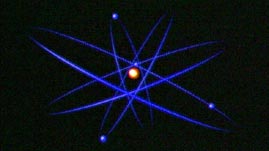By the end of the 19th century, most scientists agreed on the existence of atoms and, thanks to the work of a physicist named J.J. Thomson, knew that these structures contained particles called electrons. Thompson proposed that the atom is a sphere filled with positively charged matter that contains negatively charged electrons embedded in it like plums in a pudding.
Today's "nuclear model" of the atom, first proposed by Ernest Rutherford, is very different from Thomson's model. The nucleus, which carries all of the positive charge and 99.9 percent of the atom's mass, is at the center of the atom. Electrons orbit the nucleus at great distances -- as much as 100,000 times the diameter of the nucleus.
Although a version of this model is widely accepted by physicists today, it had what could have been a fatal problem when Rutherford first proposed it. Many physicists at the time recognized that because of their opposite charges, an electron in this configuration, without something to hold it in place, would quickly spiral into its own nucleus.
The Danish physicist Niels Bohr, who worked in Rutherford's lab, was the first to describe orbits of fixed size and energy in which electrons are free to travel without losing energy and falling toward the nucleus. According to this model, published in 1913, electrons can only occupy or jump between fixed energy levels and cannot reside in between these levels. In addition, once in their "ground state," electrons maintain the energy they contain. This energy keeps them in perpetual motion, allowing them to resist the attractive force of the nucleus.
The currently accepted model uses a mathematical approach that is different from the one that Bohr first used. However, it does not invalidate what Bohr suggested. Rather it supports his general way of looking at the atom and understanding it. In the modern quantum theory, the electrons are not described as if they were locked in precise orbits, but instead are described in terms of the probability of finding them with different amounts of energy and in different places near the nucleus. The same stability that Bohr proposed is found in the modern quantum theory. Electrons still have a minimum energy level and once at that level, they will not continue to lose energy and fall into the nucleus.


 Loading Standards
Loading Standards Teachers' Domain is proud to be a Pathways portal to the National Science Digital Library.
Teachers' Domain is proud to be a Pathways portal to the National Science Digital Library.
